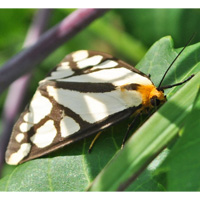Reversed Haploa Moth
Scientific name: Haploa reversa

Photo credit: aarongunnar CC BY 4.0
Status
Threatened
“Threatened” means the species lives in the wild in Ontario, is not endangered, but is likely to become endangered if steps are not taken to address factors threatening it.
Date added to the Species at Risk in Ontario List
January 25, 2023
Read the assessment report (PDF)
What it looks like
Reversed Haploa Moth is a medium-sized moth with a wingspan of 33 to 48 mm. The dorsal (top side, as seen from above) front wing pattern is composed of brown bands and white patches, including a distinctive white triangular patch extending from the thorax (the segment between the head and abdomen) to over half the length of the wing. There are three similarly sized, distinctive white patches on the leading edges of the front wings.
The larvae are black with yellow to orange lengthwise stripes. They have an orangish to reddish dorsal stripe and are covered in bristly spines.
Where it lives
Reversed Haploa Moth is associated with:
- oak savanna
- oak woodland
- dune habitats
Moth larvae in the Haploa genus are polyphagous, meaning they are able to feed on plants of many species. Moths in the Haploa genus are commonly associated with Eupatorium plant species, as well as plants in the sunflower (Asteraceae) and borage (Boraginaceae) families. Reversed Haploa Moth larvae have been observed feeding on Hairy Puccoon (Lithospermum caroliniense) in Canada.
The full range of Reversed Haploa Moth extends across North America from southeast Minnesota to Texas and western Arizona, east to North Carolina and north into southwestern Ontario.
Where it’s been found in Ontario
Reversed Haploa Moth is known from four extant (currently existing) subpopulations in southwestern Ontario, restricted to the Carolinian ecoregion. It can be found in:
- Lambton County
- Walsingham, Norfolk County
- The Coves in London
- Ojibway Prairie, Essex County
What threatens it
The widespread pesticide spraying of Bacillus thuringiensis, used to control the invasive spongy moth (Lymantria dispar dispar), is considered the highest threat to the Reversed Haploa Moth.
Other threats to Reversed Haploa Moth are associated with the decline of oak woodland and savanna habitats the species lives in, alongside the associated effects of habitat fragmentation (where one larger, continuous habitat becomes smaller, fragmented habitats).
Threats to this species also include recreational activities and inappropriate habitat management that leads to competition with invasive plant species or tree canopy closure. Climate change may also be a threat, causing larvae to emerge at a time when their larval host plants are not available, leading to their starvation.
Action we are taking
This species and its habitat are protected under Ontario’s Endangered Species Act, 2007.
The ESA also requires the preparation of recovery guidance for threatened species such as Reversed Haploa Moth to guide recovery efforts for the species in Ontario.
All species listed on the Species at Risk in Ontario List may be eligible for consideration for government funding through the Species at Risk Stewardship Program.
What you can do
Report a sighting
Submit your observations of species at risk to the Natural Heritage Information Centre (NHIC), which is Ontario’s conservation data centre. Join the “(NHIC) Rare Species of Ontario” project in iNaturalist to make submitting your observations quick and easy.
Volunteer
Volunteer with species at risk programs, such as community science surveys, through your local nature club, a provincial park or other conservation organizations.
Be a good steward
- Private landowners have a very important role to play in species recovery. If you find species at risk on your land, you may be eligible for stewardship programs that support the protection and recovery of species at risk and their habitats, such as the Species at Risk Stewardship Program.
- Invasive species seriously threaten many of Ontario’s species at risk. To learn what you can do to help reduce the threat of invasive species, visit:
Report illegal activity
Report any illegal activity related to species at risk to
Quick facts
- Reversed Haploa Moth was first recorded in Canada in 1885.
- Reversed Haploa Moth is of interest to entomologists and taxonomists because of its rarity and association with the rare and endangered habitats (oak woodland and oak savannah) in which they occur.
- Male moths in the family Erebidae (which Reversed Haploa Moth belongs to) possess some of the most physically elaborate scent-disseminating structures known among moths and butterflies.